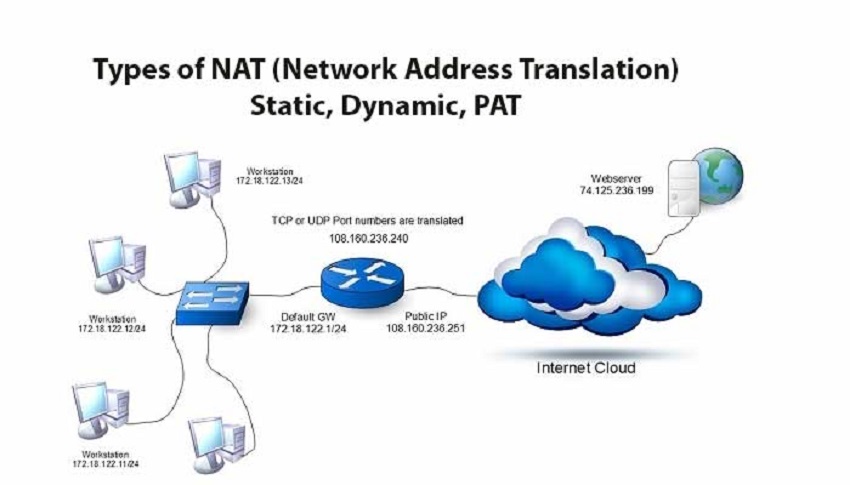If you’ve ever delved into the world of networking, you’ve probably come across the acronym NAT – Network Address Translation. It’s a fundamental concept that plays a pivotal role in enabling communication between devices in different networks. In this article, we’re going to unravel the mystery behind NAT and explore its three primary types that you should be familiar with. So, buckle up, and let’s navigate through the world of networking! This article is organized by Techconnectmagazine.com.
Understanding NAT: A Brief Overview
Network Address Translation (NAT) is a pivotal technology that allows multiple devices in a local network to share a single public IP address. It acts as an intermediary between the devices in your home or office network and the larger internet. Think of NAT as a translator – it translates private IP addresses used within your network into a single public IP address that’s visible to the outside world. This process helps conserve the limited pool of available IPv4 addresses and adds an extra layer of security. When it comes to NAT, there are different types, such as full cone vs symmetric nat, that can affect your network performance and security.
The Three Types of NAT
Static NAT
Static NAT, also known as one-to-one NAT, is like having a reserved table at a restaurant. In this scenario, a private IP address is consistently mapped to a corresponding public IP address. It’s a straightforward approach often used for devices that need to be accessed from the internet – think web servers or email servers. Static NAT ensures that every time a data packet leaves or enters the network, it knows exactly where it’s headed.
Dynamic NAT
Dynamic NAT operates like a dynamic guest list at a party. Here, a pool of public IP addresses is shared among multiple devices with private IP addresses. When a device wants to communicate with the internet, it borrows an available public IP address from the pool temporarily. Once the communication is done, the public IP address goes back to the pool for others to use. Dynamic NAT is efficient for conserving IP addresses while allowing devices to access online resources.
Port Address Translation (PAT)
Port Address Translation, often referred to as NAT Overload, is akin to a receptionist handling multiple calls for different employees at a company. PAT takes dynamic NAT a step further by not only using different IP addresses but also different port numbers to manage outgoing connections. This way, a single public IP address can serve as the entry point for numerous devices, as long as they’re using different port numbers. It’s like having a single address for an apartment complex but distinguishing residents by their unit numbers. You may like to read: 5 Tips to Reduce Data Drainage on Android
Use Cases and Applications
NAT finds its application in various scenarios. For instance, in a home network, your router likely uses NAT to allow all your devices to share the household’s single public IP address. In a corporate setting, NAT ensures that internal IP addresses remain hidden from the external world, bolstering security. Additionally, NAT is instrumental in conserving the limited number of available IPv4 addresses.
Advantages and Disadvantages of NAT
NAT comes with its set of pros and cons. On the plus side, it enhances security by keeping internal IP addresses hidden, reduces the need for IPv4 addresses, and simplifies network management. However, it can introduce complexities in some applications, such as online gaming or certain peer-to-peer connections. Some applications may require additional configuration to work seamlessly with NAT.
NAT vs. PAT: Decoding the Differences
NAT and PAT might seem similar, but they serve different purposes. NAT focuses on translating private IP addresses to a single public IP address, while PAT goes a step further by using different port numbers to distinguish between multiple connections from a single IP address. In essence, NAT is like giving a single name to a group of people, and PAT is like giving a single person multiple roles.
Common FAQs About NAT
What Is NAT Used For?
NAT is used to enable multiple devices in a local network to share a single public IP address, conserving the limited pool of available IPv4 addresses and adding a layer of security.
Is NAT a Security Feature?
Yes, NAT enhances security by keeping internal IP addresses hidden from external networks.
Can NAT Cause Connectivity Issues?
While NAT generally works seamlessly, it can sometimes pose challenges for certain applications, such as online gaming or peer-to-peer connections.
How Does NAT Impact IP Addressing?
NAT impacts IP addressing by allowing multiple devices with private IP addresses to communicate through a single public IP address.
Is NAT Still Relevant in IPv6?
With the transition to IPv6 and its larger address space, the need for NAT is reduced. However, it still has its applications, particularly in scenarios where multiple devices share a single public IP address.
Conclusion
In the vast realm of networking, Network Address Translation plays a crucial role in enabling communication between devices from different networks. By translating private IP addresses to a single public IP address, NAT ensures efficient resource utilization and heightened security. Understanding the three primary types of NAT – Static NAT, Dynamic NAT, and Port Address Translation – empowers you to optimize your network’s functionality based on your specific requirements. So, whether you’re configuring your home router or managing a corporate network, NAT’s got your back.






